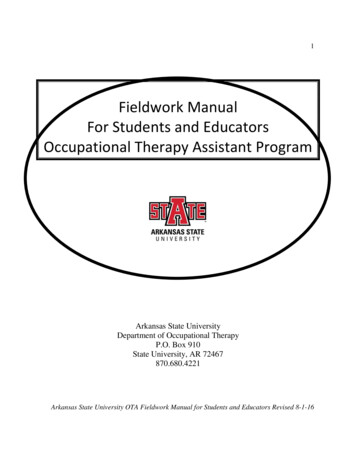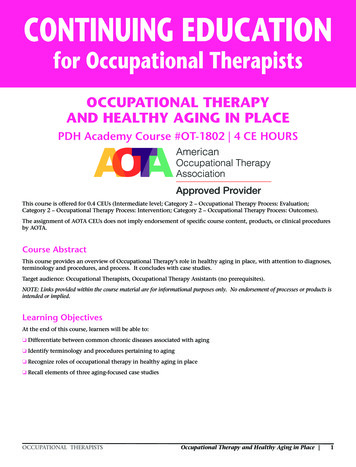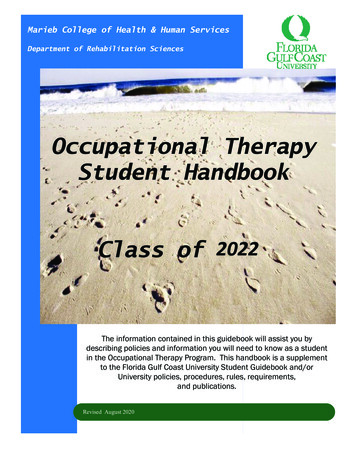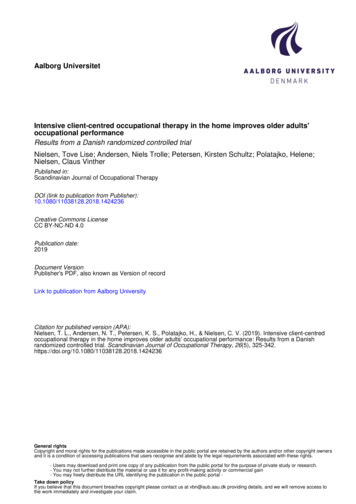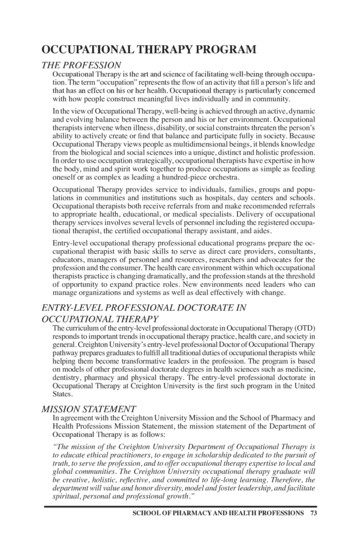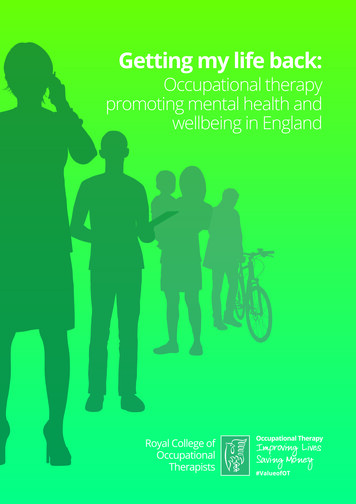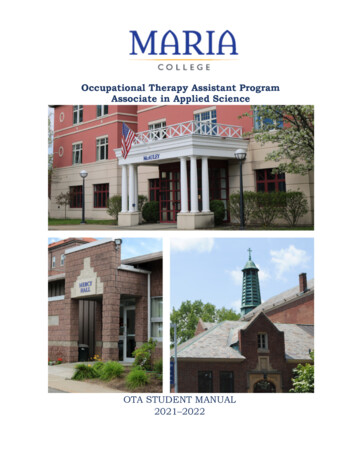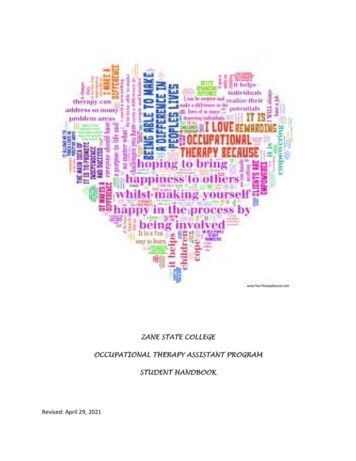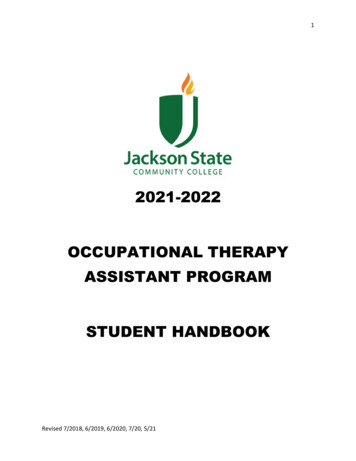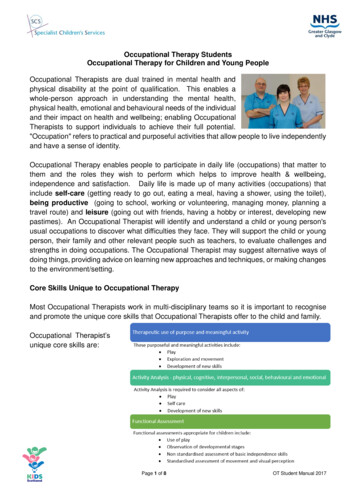
Transcription
Occupational Therapy StudentsOccupational Therapy for Children and Young PeopleOccupational Therapists are dual trained in mental health andphysical disability at the point of qualification. This enables awhole-person approach in understanding the mental health,physical health, emotional and behavioural needs of the individualand their impact on health and wellbeing; enabling OccupationalTherapists to support individuals to achieve their full potential."Occupation" refers to practical and purposeful activities that allow people to live independentlyand have a sense of identity.Occupational Therapy enables people to participate in daily life (occupations) that matter tothem and the roles they wish to perform which helps to improve health & wellbeing,independence and satisfaction. Daily life is made up of many activities (occupations) thatinclude self-care (getting ready to go out, eating a meal, having a shower, using the toilet),being productive (going to school, working or volunteering, managing money, planning atravel route) and leisure (going out with friends, having a hobby or interest, developing newpastimes). An Occupational Therapist will identify and understand a child or young person'susual occupations to discover what difficulties they face. They will support the child or youngperson, their family and other relevant people such as teachers, to evaluate challenges andstrengths in doing occupations. The Occupational Therapist may suggest alternative ways ofdoing things, providing advice on learning new approaches and techniques, or making changesto the environment/setting.Core Skills Unique to Occupational TherapyMost Occupational Therapists work in multi-disciplinary teams so it is important to recogniseand promote the unique core skills that Occupational Therapists offer to the child and family.Occupational Therapist’sunique core skills are:Page 1 of 8OT Student Manual 2017
Skills Shared with Other Disciplines1.2.3.4.5.Holistic approach.Joint prioritising of aims looking at a balance of personal, home, school and leisureactivities.Problem solving approach.Consideration of individual needs of patients.Child centred/Family centred approach encouraging control of their environment e.g.what is important to the child: What is expected at school?What does the child consider a problem and what are their goals?What are parents most concerned with?Points to Consider When Treating Children The Therapist should anticipate future problems and attempt to address them beforethey become an issue.Children need to feel safe and secure in their therapeutic environment. If they feeldisempowered or imposed upon, they will be unable to achieve the maximum benefitfrom therapy.Activities should be age appropriate and fun, as well as incorporating Therapist’s andChild’s aims.Every child is an individual.Overview of Occupational Therapy Service Delivery across GG&COccupational Therapists within Specialist Children’s Service work within the AcuteHospital (Royal Hospital for Children), within Specialist Community PaediatricTeams (SCPT) and within Child and Adolescent Mental Health Services (CAMHS)- in-patient setting and in community settings. Your placement is within theSpecialist Community Paediatric Teams.Page 2 of 8OT Student Manual 2017
Specialist Community Paediatric TeamsSpecialist Children’s Services (SCS) SpecialistCommunity Paediatric Services are provided by4 Specialist Community Paediatric Teams(SCPT) across 8 geographical bases. Eachdelivering within a sector, these teams provideservices to children and young people whorequire assessment, medical management andtherapeutic interventions, which cannot beprovided by universal and primary care healthservices. North West Sector which includes West Dunbartonshire and parts of East Dunbartonshire North East Sector which includes parts of East Dunbartonshire South Sector which includes East Renfrewshire Inverclyde and Renfrewshire SectorWith each team comprising: Community Paediatricians. Community Paediatric Nursing. Community Paediatric Physiotherapy (PT). Community Paediatric Occupational Therapy (OT). Community Paediatric Speech and Language Therapy (SLT). Administrators.SCP Teams provide services to children and young people who require assessment, medicalmanagement and therapeutic interventions, which cannot be provided by universal and primarycare health services. Care Pathways are grouped as follows:Multi-Disciplinary Care Pathways Disability Pathway Autism Pathway Vulnerable Pathway Comprehensive Medical Assessment Looked After Children (LAC)Page 3 of 8Uni-Professional Staged Care Journey Medical Nursing Allied Health Professionals (AHPs) Physiotherapy / Occupational Therapy/ Speech and Language TherapyOT Student Manual 2017
A child or young person may at any time only require input from one specific professional groupand therefore they will enter a uni-professional provision which will be tailored to their individualneeds. For clarity these provisions are described as Staged Care Journeys.The Role of Occupational TherapyThe role of the Occupational Therapist is toprovide intervention, support and/or advice tochildren and young people (0-18 years) andtheir families, where there is disability orimpairmentwhichimpactsontheirperformance and participation in everydayactivities of life.Treatment and intervention approaches are developed with the aim of enabling children andtheir carers to maximise independence and support effective self-management. This is donethrough a variety of ways: One-to-one sessions are offered at the child centre, at home, in schools and nurseries.Group sessions are held in the centre or in other community venues.These give children the opportunity to mix with others who have similar difficulties. Advice andstrategy leaflets are offered to the parents and education staff, providing them with informationto help the child. Occupational therapy is offered to children who have difficulties such as poorgross and fine motor co-ordination, poor core stability, poor motor planning skills, visualperceptual difficulties or sensory difficulties which are affecting their ability to undertake dailyactivities. The Occupational Therapists can offer advice and information sessions in schoolsto develop the staff’s knowledge of some of the difficulties the children have and how they cansupport the child.The children may have medical conditions such as: Developmental Delay.Learning Difficulty.Developmental Co-ordination Disorder (DCD).Autism Spectrum Disorder (ASD).Cerebral Palsy (CP).Down Syndrome.Muscular Dystrophy.Page 4 of 8OT Student Manual 2017
AHPs have a significant and recognised role in the inclusion and integration agenda,particularly in relation to transition and supporting children and young people with additionaleducational needs. A core function of OT is linked with disability and environmental access,including equipment to maintain and restore function as well as manage risk and addresstherapeutic needs.Care AimsThe Care Aims approach and philosophy has been identified as thepreferred service model for Community Paediatric and AcutePaediatric OT services. The Care Aims approach represents a way of defining professionalduty, governing the provision of service to both a population and to individual clients.The focus is on describing and measuring practice across all three levels of the population Universal, Targeted (stage one) and Specialist (stage two).The model looks at the impact of a presenting problem and practitioner’s ability to addressimpact at these stages of care. The Care Aims approach provides a strong strategy thatencompasses managing a service, informing the population, empowering the workforce aroundthe client and supporting the client and their family to manage their own risk wherever possible.It therefore allows services the mechanism to focus resources on greatest need/risk. The modeldescribes duty at 6 stages:Service DeliveryWe operate an open referral system which allows parents/carers and all professionals toaccess our service to ask for help.Occupational Therapy is needed when established support is in place and the child/youngperson (aged 0-18 or 19yrs if still attending secondary school or special education) continuesto experience issues with their occupations. Occupations for children/young people are:Self CareEducationDeveloping the ability to look afteryourself in areas such as dressing,personal care, mealtimes and accessingyour community.Learning and being productive is vital togive yourself a sense of purpose, suchas school work, life skills, break time &play and moving between activities.Play and LeisureHaving fun is extremely important; it isthrough play that learning happens andfriendships are formed.Page 5 of 8OT Student Manual 2017
In partnership with the child/young person and the team around them strategies forparticipation will be explored, for example: changing the way a task is done, modifications tothe environment, recommending or providing equipment, teaching the child/young person,parents or staff new techniques and/or developing the child/young person’s skills and/orabilities.Assessment and Intervention approaches used within Occupational TherapyOccupational Therapist work collaboratively with parents, education, social work and otherhealth staff to enable the child to function as fully as possible within the home and widercommunity. This is achieved by providing comprehensive assessment and treatmentprogrammes either individually or within groups at the Child Development Centre or by carryingout home and education visits e.g. nursery and schools.Assessments can be standardised or non-standardised and include use of the following tests:Test of Visual MotorIntegration (VMI)Developmental Test ofVisual Perception (DTVP 3)Movement AssessmentBattery for Children version2 (Movement ABC-2)Test of Visual-PerceptualSkills (TVPS-R)The Sensory ProfilePerceived Efficacy and Goalsetting System (PEGS)Detailed Assessment ofHandwriting (DASH)Non-standardised tests include Clinical Observations, Functional and Developmentalchecklists as deemed appropriate by the Occupational Therapist, as well as observations in avariety of settings (clinic, school, nursery and home).The aim of assessment is to establish a baseline of the child’s level of functioning, reviewprogress, or evaluate possible deterioration, and to contribute to the diagnostic process.Assessment reports are provided following initial assessment. Reports may also be requiredfor Co-ordinated Support Plan meetings, Future Needs meetings, Review meetings and attransition e.g. primary to secondary school. The service uses the ‘Care Aims’ Model.It is essential to refer to the manuals for any of the Standardised Tests to obtain specificinformation on the Test criteria, administration, age limits, task’s assessed, and scoring.Page 6 of 8OT Student Manual 2017
All staff using standardised tests should follow the instructions explicitly as any changes inadministration can invalidate the results. Standardised tests should also only be used to carryout more in depth assessment of a child’s ability and not as the only assessment tool available.Sometimes children may score low on a standardised test, but actually be functioning withinacceptable or normal limits.Evidence based Interventions are detailed within our clinical pathways. These documents aresaved on the s drive, please request access from your practice educator.Goal Setting and Outcome MeasuresSetting goals can help us to: Remain person-centred. Remain occupation focussed and therefore improve health & well-being. Effective and efficient. Contribute to outcome measurement.A good quality goal is: Person centred - meaningful to the person in question. Clear - instantly understandable to the child, family and the team around them. Specific - have specific criterion that can be used to indicate goal achievement. Time limited.SMART GoalsSpecificWell defined andclear to thoseinvolvedMeasurableCan we becertain whetherthe goal has/hsnot beenachieved?TimedWhen do weexpect thegoal to bemet?RealisticReasonablegiven theresources,knowledge andskillsPage 7 of 8AgreedCollaborativeprocess withthe client so itis meaningfulOT Student Manual 2017
Measuring Outcome“Outcome measurement can demonstrate the effectiveness of intervention for individualservice users or population groups, guiding further decision-making and/or intervention. Theuse of outcome measures, especially standardised measures, allows occupational therapiststo build up and use a body of evidence for occupational therapy.” (COT 2015, p2)Outcomes measures can include: Improvements in health and/or well-being. Improvements in function or level of independence. Attainment of intervention goals. Service user satisfaction. System changes such as reduced hospital length of stay, shorter waiting lists, and lowerreadmission rates.Our outcomes should be person and occupation focussed. An outcome measure can be assimple as whether or not a goal is achieved. Outcome measures need to be appropriate forthe specific measurement purpose. You may need more than one outcome measure toprovide comprehensive information about the outcomes for each service user.Page 8 of 8OT Student Manual 2017
Occupational Therapy enables people to participate in daily life (occupations) that matter to . play and moving between activities. Play and Leisure Having fun is extremely important; it is . to build up and use a body of evidence for occupational therapy." (COT 2015, p2) Outcomes measures can include:
